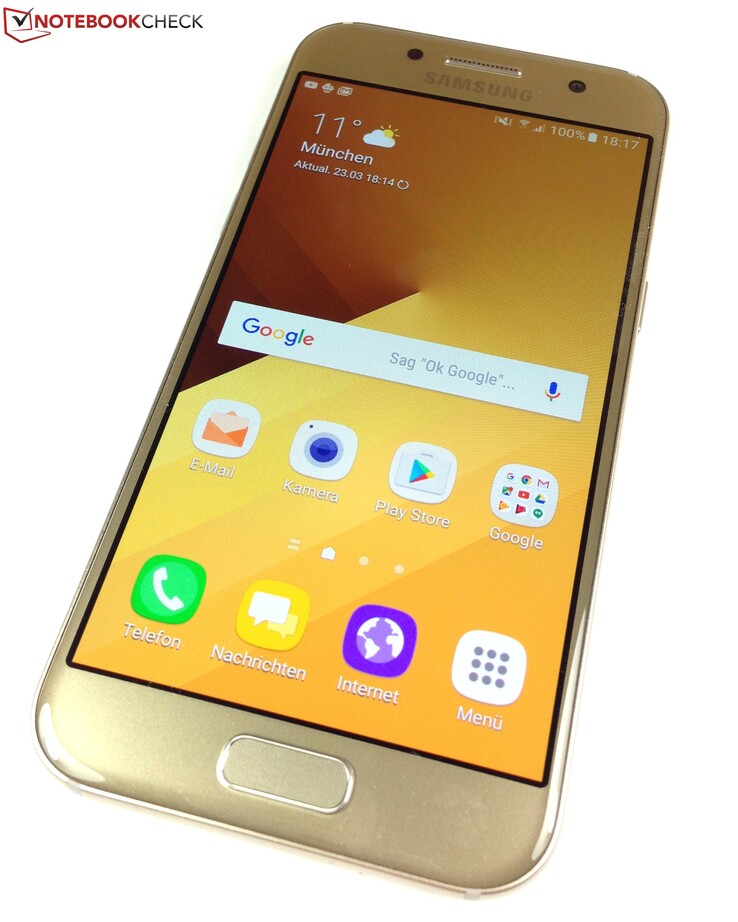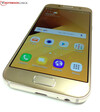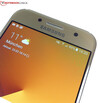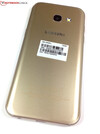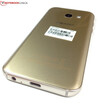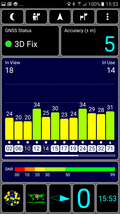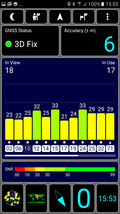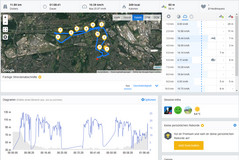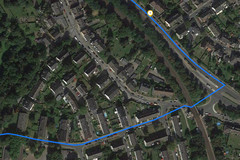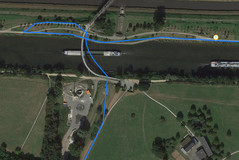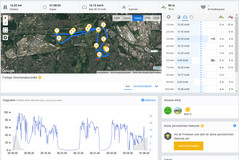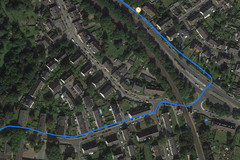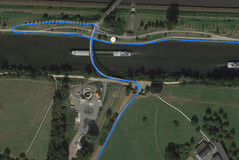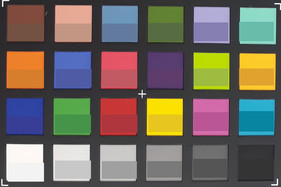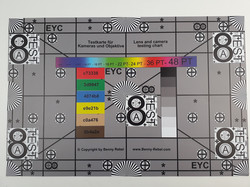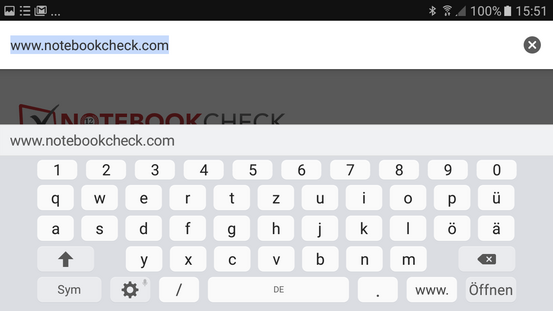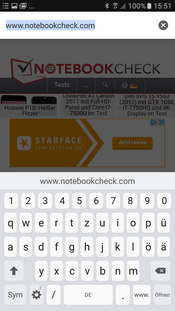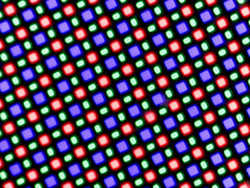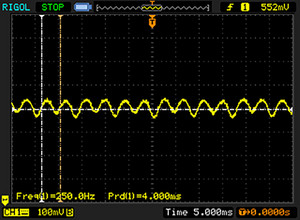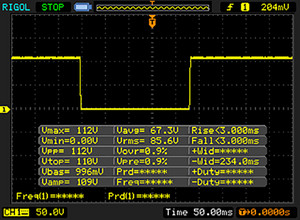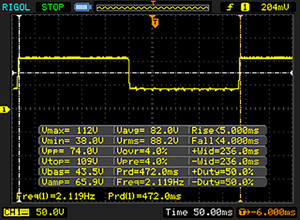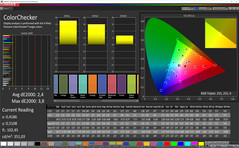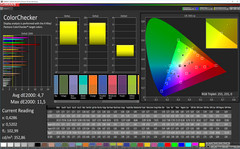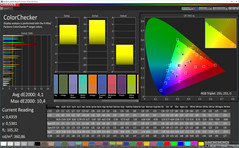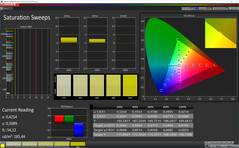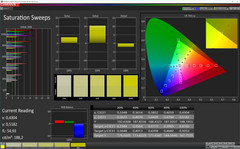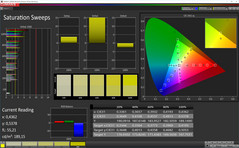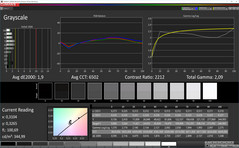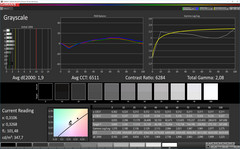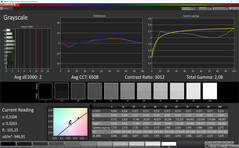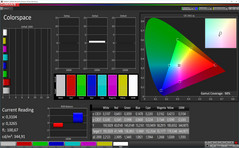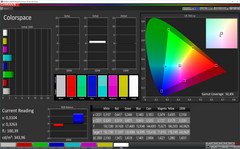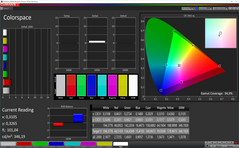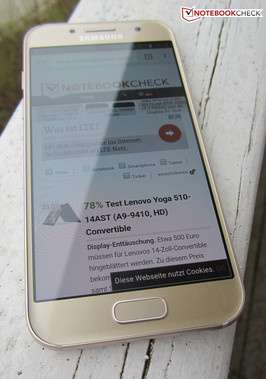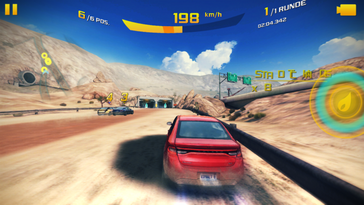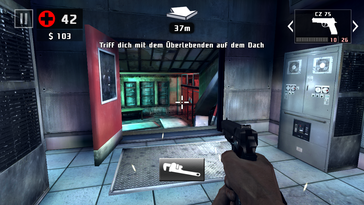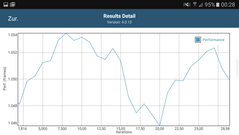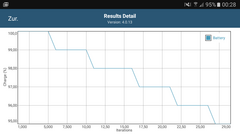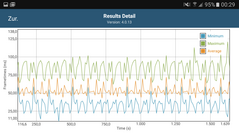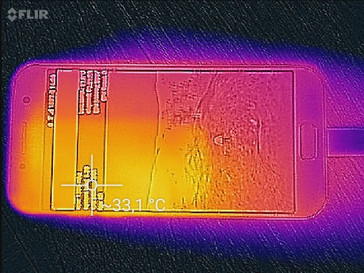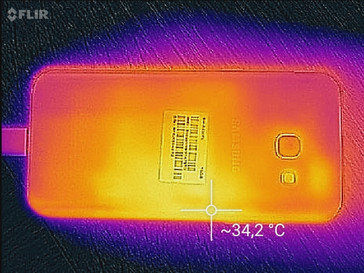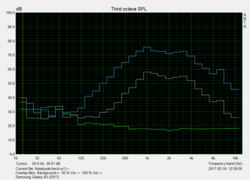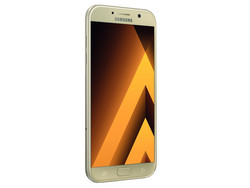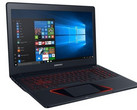Samsung Galaxy A3 (2017) Smartphone Review
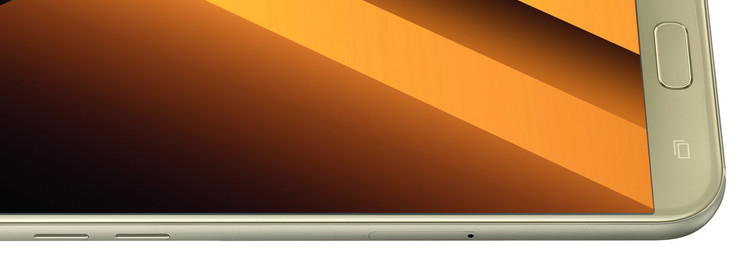
For the original German review, see here.
Remake, round three: following its Galaxy A7 and Galaxy A5 Samsung has now also presented an updated 2017 model of its Galaxy A3. This latest reincarnation of the mid-range smartphone first introduced in 2015 is once again trying to woo us with its hip design, its high-quality build, and its decent performance. The Galaxy A3 (2017) features an octa-core Samsung Exynos 7 Octa 7870 SOC and 16GB of storage. It comes with LTE Cat. 4, 802.11 ac Wi-Fi, an AMOLED display, NFC, and two cameras with 13 and 8 megapixels, respectively, and it costs 329 Euros (~$351).
Like its predecessors, the Galaxy A3 (2017) once more features a 4.7-inch 1280x720 display and a form factor almost unique in its particular mid-range market segment. Still, we've managed to find a few competitors that we pitched it against: the BQ Aquaris X5 Plus, the HTC One A9s, the Huawei Nova, the Lenovo ZUK Z2, and the Wiko U Feel Prime. Of course, we're also comparing it to its older sibling, the Galaxy A3 (2016).
Case
Our review unit comes in “gold sand”, which is one of four available colors; “blue mist”, “black sky”, and “peach cloud” are the other three. Thanks to its rounded corners and its edges merging seamlessly with the curved Gorilla Glass-protected AMOLED display each one of these looks classy in its own way.
This is further reinforced by the glass-covered back side which gives us a glimpse of the very rigid metal chassis. Unlike its predecessor, whose chassis was visually separated by a silver frame, the A3’s chassis is made of one piece and feels this way, too. On the one hand this choice of material makes it gentle to the touch, on the other it needs to be handled with care in order to avoid scratches. The fingerprint-reader is hidden inside the home button.
The camera and LED flash on the back side neither protrude from the case nor are there any noticeable gaps, which means the smartphone doesn’t wobble when placed on a flat surface. The IP68 rating means it can be submerged in 1.5 meters (5 feet) of water for up to 30 minutes without any damage to the device. This obviously requires the nano-SIM and MicroSD-card slot to be closed, and the phone displays a warning message in case the tray has been ejected, accordingly.
With its 4.7-inch display the Galaxy A3 (2017) is roughly the same size as its predecessor, the Galaxy A3 (2016), although it is 1 mm wider (66.2 vs. 65.2 mm) and 0.5 mm thicker (7.4 vs. 7.9 mm). These minor differences are barely noticeable even when both phones are placed right next to each other. At 138 g it has also gotten a mere 7 g heavier, but it's still the lightest contestant in our test group.
Connectivity
The Galaxy A3 (2017) is powered by the in-house 64-bit Samsung Exynos 7 Octa 7870 with 2 GB of RAM and an ARM Mali-T830 MP1 GPU. Out of the box only 9.8 GB of its 16 GB storage space is available, and Samsung does not offer additional tiers. However, a MicroSD-card expansion of up to 256 GB is supported and apps can be saved to SD storage. While some apps do not support this we've had no issues with the likes of 3DMark, Asphalt 8: Airborne, or Dead Trigger 2, which when combined took up more than 2 GB of storage. Unfortunately, the MicroSD card slot cannot be used as a secondary SIM-card slot.
The reversible USB Type-C port only supports USB 2.0 speeds, but it does have OTG capabilities. Since Samsung had to cut corners here and there – this is after all a mid-range device – the Galaxy A3 doesn’t support MHL or Qi wireless charging, but it does have Wi-Fi Direct capabilities allowing wireless display sync.
Software
With Android 6.0.1 Marshmallow as OS, the Galaxy A3 (2017) features Samsung’s custom user interface called “Grace UX”. An update to Android 7.0 Nougat has already been announced but had not yet been released at the time of writing (late March 2017).
The Grace UX user interface alters Android’s default GUI slightly. In addition to a news ticker located left of the home screen, a so-called “Background and Themes” setting allows customization thereof. Like its predecessor, the A3 (2017) supports “Smart Stay”, a feature that relies on the front-facing camera and which leaves the display powered on as long as the user is looking at the screen regardless of configured display timeouts.
Fortunately, the amount of pre-loaded bloatware is fairly low, and the preinstalled apps are limited to Google’s default software suite, some Microsoft apps such as OneDrive, Excel, or Skype, and Samsung’s own apps including S Health and S Voice. A Samsung app we liked is "Secure Folder", which allows moving apps and files into a securely locked environment thus preventing unauthorized access.
Communication and GPS
The Galaxy A3 (2017) supports quad-band GMS and UMTS and a total of eight frequency bands for LTE Cat. 4 connectivity. A nano-SIM is required, and with ample carrier support the device is capable of speeds of up to 150 Mbit/s (download) and 50 Mbit/s (upload), respectively.
Wi-Fi capabilities include 802.11 a, b, g, and ac in both the 2.4 GHz and 5 GHz frequency ranges. It did very well during our tests and managed to send up to 225 Mbit/s and receive up to 305 Mbit/s. This means it beats its HTC, Huawei and Wiko competitors but it is bested slightly by the BQ Aquaris X5 Plus and the Lenovo ZUK Z2. Short distance communication via Bluetooth 4.2 and NFC is also supported.
| Networking | |
| iperf3 transmit AX12 | |
| Lenovo ZUK Z2 | |
| BQ Aquaris X5 Plus | |
| Samsung Galaxy A3 2017 | |
| HTC One A9s | |
| Wiko U Feel Prime | |
| Huawei Nova | |
| iperf3 receive AX12 | |
| BQ Aquaris X5 Plus | |
| Samsung Galaxy A3 2017 | |
| Lenovo ZUK Z2 | |
| HTC One A9s | |
| Wiko U Feel Prime | |
| Huawei Nova | |
Location services include support for GPS and GLONASS, and the Galaxy A3 (2017) does very well. Indoors it was capable of determining its correct location within 6 meters (roughly 20 feet); outdoors it managed an accuracy of 5 meters (16 feet). Pitched against the professional Garmin Edge 500 GPS on our 12 km-long bicycle test track the Galaxy A3 (2017) held its ground fairly well. Even though it lacked the Garmin’s precision the accumulated difference in travel distance was only 300 meters (985 feet). This translates to more than adequate and sufficient precision for everyday use.
Telephone and Call Quality
Samsung’s custom Grace UX interface of the phone app offers the same features as Google’s stock Android phone app: favorites, a call log, and access to the contacts. The settings include additional features, such as caller management to block specific numbers. It also offers different choices of how one wants to answer the phone, e.g. by pressing the home button or even automatically after a pre-set configurable waiting period.
Call quality was good during our test calls in Vodafone’s 3G network regardless of whether we used the built-in microphone or the included headset. Using the hands-free speakerphone, voice transmission was rather quiet but not yet disruptively so. Background noise was cancelled very efficiently, and we did not experience any dropped calls during our tests.
Cameras
Just like its predecessor, the Galaxy A3’s main camera captures 13 megapixels (4128x3096), features an aperture of f/1.9, and it has an LED flash. The optional 16:9 aspect ratio reduces the resolution to 9.6 megapixels (4128x2322). Compared to the Galaxy A3 (2016) the front-facing camera was bumped from 5 to 8 megapixels. The rear camera now also sits flush with the back cover and does not protrude from it anymore, which prevents wobbling when placed on its back side.
The main camera did well in our tests. Photos taken in good lighting conditions were ever so slightly oversaturated but overall very well balanced in terms of dynamic range, sharpness, and details. Low-light images did show a noticeable amount of noise and lack of sharpness due to the lack of optical image stabilization but were overall still very usable. However, low-light conditions were a problem for the autofocus, and its troubles with focusing were somewhat alleviated by the activation of the LED flash.
In addition to Auto mode the camera menu also supports a Professional mode, which allows manual adjustments of ISO sensitivity, white balance, and shutter speed. It also supports preconfigured picture modes, such as panorama or HDR photography and – as a special feature – a food mode for showcasing one's food shots. The included predefined filters are self-explanatory and carry names such as Saturation, Cream, Woods, Grayscale, or Nostalgia. Videos are recorded at 30 frames per second with a resolution of up to 1920x1080, and video quality is very decent.
The 8-megapixel f/1.9 aperture front-facing camera features presets such as Selfie or Group-Selfie and is clearly optimized for self-portrayal, which works quite well under decent lighting conditions. Like the main camera, the front-facing camera captures video in Full HD at 30 frames per second.
To determine the color accuracy of the Galaxy A3’s main camera we've used a photo of the X-Rite ColorChecker Passport taken under predefined lighting conditions, and we compared it to the actual reference colors. The photo was not post-processed at all, meaning there was no manual post-photography adjustment of white balance or other aspects.
The result is rather colorful – compared to the reference colors the Galaxy A3’s colors and grayscales tend to be a bit oversaturated and too bright.
Similarly, a photo of our reference card taken under predefined lighting conditions was used to determine the Galaxy A3’s main camera’s sharpness and clarity. The result is somewhat mixed: the bottom left corner is noticeably blurry; the center of the image is very sharp and clear.
Accessories and Warranty
Included with the Galaxy A3 (2017) are a modular charger (5V, 1.55A), a USB Type-C cable, a headset, a SIM-card removal tool, a quick-start guide, and a warranty card. In addition, accessories such as a flip cover, a clear cover, and a screen protector can be purchased separately.
The Galaxy A3 (2017) comes with a 24-month warranty on the phone itself, a 12-month warranty on wear and tear parts such as the charger, the headset, or the USB cable, and a 6-month warranty on the battery.
Please see our Guarantees, Return Policies and Warranties FAQ for country-specific information.
Input Devices and Handling
Thanks to its curved glass edges the Galaxy A3 (2017)’s touchscreen is not only very gentle to the touch but is also very accurate. Flipping through menus or rotating the screen is blazingly fast and the phone didn’t disappoint even with multiple apps open simultaneously. Occasionally, the UI did stutter, for example when switching between complex applications or during an update process running in the background. The stutter was never really disruptive, though.
The preinstalled Samsung touch keyboard offers a very good compromise between number of keys and the limited space inherent to small displays. By default, a row of numbers is displayed and the keyboard supports gestures and Google’s voice commands, makes suggestions, uses autocorrect, and it is adjustable in height. In landscape mode it uses roughly half of the available screen estate; in portrait mode it uses a bit more than a third.
The smartphone’s physical buttons – a volume rocker, a power button, and the home button – all have very precise actuation points and no noticeable play. The home button includes a solid and reliable fingerprint-reader. Both the back and menu button are soft-touch buttons that illuminate for a short time when activated.
Display
The Galaxy A3 (2017)’s Super AMOLED display measures 4.7-inches and features a 1280x720 resolution, resulting in a pixel density of 312 ppi. While this equals its predecessor, the display of this year's model is noticeably brighter.
An average evenly distributed (94%) brightness of 576 nits with activated ambient light sensor is very impressive. It reaches even higher levels of up to 693 nits during the APL 50 tests (Average Picture Level) in which bright and dark segments are evenly distributed over the entire screen. Disabling the ambient light sensor caps the maximum brightness at a reasonable 345 nits.
Since AMOLED displays allow black levels of zero the contrast ratio is - in theory - infinite. Thus, colors pop and are very well saturated, and all things considered we found no issues with the Galaxy A3’s display. However, PWM-flickering might be noticeable to some users at brightness levels of 92% or less.
| |||||||||||||||||||||||||
Brightness Distribution: 94 %
Center on Battery: 574 cd/m²
Contrast: ∞:1 (Black: 0 cd/m²)
ΔE ColorChecker Calman: 2.4 | ∀{0.5-29.43 Ø4.77}
ΔE Greyscale Calman: 1.9 | ∀{0.09-98 Ø5}
Gamma: 2.09
CCT: 6502 K
| Samsung Galaxy A3 2017 Super AMOLED, 1280x720, 4.7" | BQ Aquaris X5 Plus IPS, 1920x1080, 5" | Huawei Nova IPS, 1920x1080, 5" | HTC One A9s IPS, 1280x720, 5" | Lenovo ZUK Z2 IPS, 1920x1080, 5" | Wiko U Feel Prime IPS, 1920x1080, 5" | Samsung Galaxy A3 2016 Super AMOLED, 1280x720, 4.7" | |
|---|---|---|---|---|---|---|---|
| Screen | -16% | -47% | -53% | -55% | -51% | 4% | |
| Brightness middle (cd/m²) | 574 | 640 11% | 493 -14% | 348 -39% | 512 -11% | 411 -28% | 386 -33% |
| Brightness (cd/m²) | 576 | 609 6% | 485 -16% | 320 -44% | 502 -13% | 386 -33% | 394 -32% |
| Brightness Distribution (%) | 94 | 85 -10% | 94 0% | 85 -10% | 84 -11% | 86 -9% | 88 -6% |
| Black Level * (cd/m²) | 0.93 | 0.44 | 0.23 | 0.58 | 0.36 | ||
| Colorchecker dE 2000 * | 2.4 | 2.8 -17% | 4.2 -75% | 3.5 -46% | 3.8 -58% | 4.3 -79% | 1.11 54% |
| Colorchecker dE 2000 max. * | 3.8 | 5.7 -50% | 6.6 -74% | 6.4 -68% | 11.2 -195% | 7.9 -108% | 3.35 12% |
| Greyscale dE 2000 * | 1.9 | 2.6 -37% | 3.8 -100% | 4 -111% | 2.7 -42% | 2.8 -47% | 1.34 29% |
| Gamma | 2.09 105% | 2.35 94% | 2.39 92% | 2.3 96% | 2.09 105% | 2.53 87% | 2.12 104% |
| CCT | 6502 100% | 6477 100% | 7438 87% | 6527 100% | 6076 107% | 6589 99% | 6441 101% |
| Contrast (:1) | 688 | 1120 | 1513 | 883 | 1142 |
* ... smaller is better
Screen Flickering / PWM (Pulse-Width Modulation)
| Screen flickering / PWM detected | 250 Hz | ||
The display backlight flickers at 250 Hz (worst case, e.g., utilizing PWM) . The frequency of 250 Hz is relatively low, so sensitive users will likely notice flickering and experience eyestrain at the stated brightness setting and below. In comparison: 53 % of all tested devices do not use PWM to dim the display. If PWM was detected, an average of 8084 (minimum: 5 - maximum: 343500) Hz was measured. | |||
Display Response Times
| ↔ Response Time Black to White | ||
|---|---|---|
| 6 ms ... rise ↗ and fall ↘ combined | ↗ 3 ms rise | |
| ↘ 3 ms fall | ||
| The screen shows very fast response rates in our tests and should be very well suited for fast-paced gaming. In comparison, all tested devices range from 0.1 (minimum) to 240 (maximum) ms. » 17 % of all devices are better. This means that the measured response time is better than the average of all tested devices (20.2 ms). | ||
| ↔ Response Time 50% Grey to 80% Grey | ||
| 9 ms ... rise ↗ and fall ↘ combined | ↗ 5 ms rise | |
| ↘ 4 ms fall | ||
| The screen shows fast response rates in our tests and should be suited for gaming. In comparison, all tested devices range from 0.165 (minimum) to 636 (maximum) ms. » 21 % of all devices are better. This means that the measured response time is better than the average of all tested devices (31.6 ms). | ||
Several color presets can be chosen from in the phone’s settings. With its grayscale accuracy of DeltaE 1.9 and its color accuracy of DeltaE 2.4 "Simple" is the most accurate sRGB preset. As such, it is well within the optimum of DeltaE < 3, and at the very top of its range. The only smartphone with an even more accurate out-of-the-box color presentation is its own predecessor, the Galaxy A3 (2016).
The two color modes called “AMOLED Photo” and “AMOLED Video” are significantly less accurate, with a color accuracy of DeltaE 4.7 and 4.1, respectively. This might be due to the fact that while we measured sRGB accuracy the “AMOLED Photo” mode uses AdobeRGB instead. Notwithstanding that, color temperature for both profiles and Gamma for all three profiles are near perfect. By default, the phone’s self-adjustable auto mode is enabled.
Thanks to the combination of ultra-bright display and AMOLED panel the Galaxy A3 (2017) is well-equipped to be used outdoors. Unlike smartphones with IPS panels even direct sunlight doesn’t render it useless, and display content is still recognizable.
Another benefit of the AMOLED panel is its superb viewing angles. Even when viewed from extreme angles, display brightness remains unchanged and only color temperature drops slightly, shifting the display slightly towards the blue end of the spectrum.
Performance
The Galaxy A3’s in-house octa-core Samsung Exynos 7 Octa 7870 SOC is supported by the ARM Mali-T830 MP1 GPU and has access to 2 GB of RAM. While this mix doesn’t make for a top performer it isn’t half bad and the phone offers a decent overall performance. It’s certainly fast enough for everyday apps and a game or two. In synthetic benchmarks, our review unit beat its own Exynos 7578-equipped predecessor, the Galaxy A3 (2016), albeit the difference between the two is negligible. The HTC One A9s, the Huawei Nova, and the Wiko U Feel Prime were about as fast as the Galaxy A3 (2017) and all four had to bow to the significantly better-performing BQ Aquaris X5 Plus. However, none of these was fit to hold a candle to the Lenovo ZUK Z2.
| AnTuTu v6 - Total Score (sort by value) | |
| Samsung Galaxy A3 2017 | |
| BQ Aquaris X5 Plus | |
| Huawei Nova | |
| HTC One A9s | |
| Lenovo ZUK Z2 | |
| Wiko U Feel Prime | |
| Samsung Galaxy A3 2016 | |
| Geekbench 4.0 | |
| 64 Bit Single-Core Score (sort by value) | |
| Samsung Galaxy A3 2017 | |
| BQ Aquaris X5 Plus | |
| Huawei Nova | |
| HTC One A9s | |
| Wiko U Feel Prime | |
| 64 Bit Multi-Core Score (sort by value) | |
| Samsung Galaxy A3 2017 | |
| BQ Aquaris X5 Plus | |
| Huawei Nova | |
| HTC One A9s | |
| Wiko U Feel Prime | |
| GFXBench (DX / GLBenchmark) 2.7 | |
| T-Rex Onscreen (sort by value) | |
| Samsung Galaxy A3 2017 | |
| BQ Aquaris X5 Plus | |
| Huawei Nova | |
| HTC One A9s | |
| Lenovo ZUK Z2 | |
| Wiko U Feel Prime | |
| Samsung Galaxy A3 2016 | |
| 1920x1080 T-Rex Offscreen (sort by value) | |
| Samsung Galaxy A3 2017 | |
| BQ Aquaris X5 Plus | |
| Huawei Nova | |
| HTC One A9s | |
| Lenovo ZUK Z2 | |
| Wiko U Feel Prime | |
| Samsung Galaxy A3 2016 | |
| GFXBench 3.0 | |
| on screen Manhattan Onscreen OGL (sort by value) | |
| Samsung Galaxy A3 2017 | |
| BQ Aquaris X5 Plus | |
| Huawei Nova | |
| HTC One A9s | |
| Lenovo ZUK Z2 | |
| Wiko U Feel Prime | |
| Samsung Galaxy A3 2016 | |
| 1920x1080 1080p Manhattan Offscreen (sort by value) | |
| Samsung Galaxy A3 2017 | |
| BQ Aquaris X5 Plus | |
| Huawei Nova | |
| HTC One A9s | |
| Lenovo ZUK Z2 | |
| Wiko U Feel Prime | |
| Samsung Galaxy A3 2016 | |
| GFXBench 3.1 | |
| on screen Manhattan ES 3.1 Onscreen (sort by value) | |
| Samsung Galaxy A3 2017 | |
| BQ Aquaris X5 Plus | |
| Huawei Nova | |
| HTC One A9s | |
| Lenovo ZUK Z2 | |
| Wiko U Feel Prime | |
| 1920x1080 Manhattan ES 3.1 Offscreen (sort by value) | |
| Samsung Galaxy A3 2017 | |
| BQ Aquaris X5 Plus | |
| Huawei Nova | |
| HTC One A9s | |
| Lenovo ZUK Z2 | |
| Wiko U Feel Prime | |
| PCMark for Android - Work performance score (sort by value) | |
| Samsung Galaxy A3 2017 | |
| BQ Aquaris X5 Plus | |
| Huawei Nova | |
| HTC One A9s | |
| Lenovo ZUK Z2 | |
| Wiko U Feel Prime | |
| Samsung Galaxy A3 2016 | |
The BQ Aquaris X5 Plus and the Lenovo ZUK Z2 spearhead the browser-benchmark results with the rest of the field, including the Galaxy A3 (2017), trailing behind. It was all but impossible to determine a clear-cut order since each benchmark run presented us with a different arrangement.
| Octane V2 - Total Score (sort by value) | |
| Samsung Galaxy A3 2017 | |
| BQ Aquaris X5 Plus | |
| Huawei Nova | |
| HTC One A9s | |
| Lenovo ZUK Z2 | |
| Wiko U Feel Prime | |
| Samsung Galaxy A3 2016 | |
| Mozilla Kraken 1.1 - Total (sort by value) | |
| Samsung Galaxy A3 2017 | |
| BQ Aquaris X5 Plus | |
| Huawei Nova | |
| HTC One A9s | |
| Lenovo ZUK Z2 | |
| Wiko U Feel Prime | |
| Samsung Galaxy A3 2016 | |
| WebXPRT 2015 - Overall (sort by value) | |
| Samsung Galaxy A3 2017 | |
| Huawei Nova | |
| HTC One A9s | |
| Samsung Galaxy A3 2016 | |
| JetStream 1.1 - Total Score (sort by value) | |
| Samsung Galaxy A3 2017 | |
| BQ Aquaris X5 Plus | |
| Huawei Nova | |
| HTC One A9s | |
| Lenovo ZUK Z2 | |
| Wiko U Feel Prime | |
| Samsung Galaxy A3 2016 | |
* ... smaller is better
Even though it performed better than its own predecessor in the internal memory read and write benchmarks, the Galaxy A3 (2017) was only fast enough to make it to the bottom half of the list, with the Wiko U Feel Prime, the Huawei Nova, and the HTC One A9s utterly dismantling the competition. Accessing our reference SD card, a Toshiba Exceria Pro M401 with read and write speeds of up to 95 MB/s and 80 MB/s, respectively, paints a completely different picture though. While none of the contestants were able to max out the card, the BQ Aquaris X5 Plus, the Huawei Nova, and the Galaxy A3 (2017) at least came close.
| Samsung Galaxy A3 2017 Mali-T830 MP1, 7870 Octa, 16 GB eMMC Flash | BQ Aquaris X5 Plus Adreno 510, 652 MSM8976, 16 GB eMMC Flash | Huawei Nova Adreno 506, 625, 32 GB eMMC Flash | HTC One A9s Mali-T860 MP2, Helio P10 MT6755, 32 GB eMMC Flash | Lenovo ZUK Z2 Adreno 530, 820 MSM8996, 64 GB eMMC Flash | Wiko U Feel Prime Adreno 505, 430, 32 GB eMMC Flash | Samsung Galaxy A3 2016 Mali-T720 MP2, 7578, 16 GB eMMC Flash | |
|---|---|---|---|---|---|---|---|
| AndroBench 3-5 | 20% | 87% | 35% | -6% | 51% | -13% | |
| Sequential Read 256KB (MB/s) | 199.7 | 228.4 14% | 248.3 24% | 210.2 5% | 239.4 20% | 270.9 36% | 168.8 -15% |
| Sequential Write 256KB (MB/s) | 45.96 | 47.03 2% | 75 63% | 68.6 49% | 46.52 1% | 137.3 199% | 27.27 -41% |
| Random Read 4KB (MB/s) | 22.32 | 36.85 65% | 38.19 71% | 21.3 -5% | 21.27 -5% | 55 146% | 21.92 -2% |
| Random Write 4KB (MB/s) | 9.62 | 12.44 29% | 44.63 364% | 34.6 260% | 5.64 -41% | 9.4 -2% | 10.27 7% |
| Sequential Read 256KB SDCard (MB/s) | 75.5 | 73.2 -3% | 79.5 5% | 39.6 -48% | 41.98 -44% | ||
| Sequential Write 256KB SDCard (MB/s) | 50.1 | 54.9 10% | 47.69 -5% | 25.6 -49% | 35.21 -30% |
Games
Given its fairly powerful mid-range ARM Mali-T830 MP1 GPU, the Samsung Galaxy A3 (2017) should perform very well in most current Android games. Occasionally it might be necessary to reduce details in order to improve performance and avoid stuttering. The rather demanding Dead Trigger 2 performed very well with 52 frames per second at its highest detail level. Asphalt 8: Airborne only managed to render 23 frames per second with its details maxed out, therefore stuttering slightly. Both the touchscreen and its acceleration sensors were very accurate and fast.
| Asphalt 8: Airborne | |||
| Settings | Value | ||
| high | 23 fps | ||
| very low | 29 fps | ||
| Dead Trigger 2 | |||
| Settings | Value | ||
| high | 52 fps | ||
Emissions
Temperature
After a full hour of stress testing the Galaxy A3 (2017) remained at acceptable temperature levels. We found it to reach a maximum temperature of 32 °C (90 °F) under load and a very low 27.7 °C (82 °F) when idle. As expected, the device does not throttle under load and frame rates remained stable even after 30 reruns of the GFXBench’s T-Rex benchmark.
(+) The maximum temperature on the upper side is 31.8 °C / 89 F, compared to the average of 35.2 °C / 95 F, ranging from 21.9 to 247 °C for the class Smartphone.
(+) The bottom heats up to a maximum of 32 °C / 90 F, compared to the average of 34 °C / 93 F
(+) In idle usage, the average temperature for the upper side is 27.3 °C / 81 F, compared to the device average of 32.9 °C / 91 F.
Speaker
With each reiteration of the Galaxy A3, the speaker roams the device rather freely and ends up someplace else. While the 2015 Galaxy A3 featured a rear-mounted speaker, last year’s Galaxy A3 (2016) had it placed at the bottom next to the Micro USB port. This year, Samsung went with the left-hand side next to the power button. As with last year’s model this means the sound is not muffled when the phone is placed flat on a table.
Being a mono speaker, we didn’t expect it to be much good, yet it surprised us with its decent performance. Reaching a volume of almost 83 dB(A) it was acceptably loud and didn't produce any noticeable distortion even at maximum volume. If you listen very closely there’s even a hint of bass. The included headphones are even better.
Samsung Galaxy A3 2017 audio analysis
(+) | speakers can play relatively loud (82.6 dB)
Bass 100 - 315 Hz
(-) | nearly no bass - on average 19.2% lower than median
(±) | linearity of bass is average (9.7% delta to prev. frequency)
Mids 400 - 2000 Hz
(±) | higher mids - on average 8.7% higher than median
(±) | linearity of mids is average (7.4% delta to prev. frequency)
Highs 2 - 16 kHz
(±) | higher highs - on average 5.6% higher than median
(+) | highs are linear (6.9% delta to prev. frequency)
Overall 100 - 16.000 Hz
(±) | linearity of overall sound is average (26.1% difference to median)
Compared to same class
» 66% of all tested devices in this class were better, 6% similar, 28% worse
» The best had a delta of 11%, average was 35%, worst was 134%
Compared to all devices tested
» 80% of all tested devices were better, 4% similar, 16% worse
» The best had a delta of 4%, average was 24%, worst was 134%
Samsung Galaxy A3 2016 audio analysis
(+) | speakers can play relatively loud (84.4 dB)
Bass 100 - 315 Hz
(-) | nearly no bass - on average 32.6% lower than median
(±) | linearity of bass is average (11.5% delta to prev. frequency)
Mids 400 - 2000 Hz
(+) | balanced mids - only 3.2% away from median
(+) | mids are linear (6.5% delta to prev. frequency)
Highs 2 - 16 kHz
(+) | balanced highs - only 4% away from median
(+) | highs are linear (5.5% delta to prev. frequency)
Overall 100 - 16.000 Hz
(±) | linearity of overall sound is average (22.8% difference to median)
Compared to same class
» 50% of all tested devices in this class were better, 6% similar, 44% worse
» The best had a delta of 11%, average was 35%, worst was 134%
Compared to all devices tested
» 67% of all tested devices were better, 6% similar, 28% worse
» The best had a delta of 4%, average was 24%, worst was 134%
HTC One A9s audio analysis
(+) | speakers can play relatively loud (82.6 dB)
Bass 100 - 315 Hz
(-) | nearly no bass - on average 18.2% lower than median
(±) | linearity of bass is average (13.5% delta to prev. frequency)
Mids 400 - 2000 Hz
(±) | higher mids - on average 5.4% higher than median
(+) | mids are linear (5.4% delta to prev. frequency)
Highs 2 - 16 kHz
(±) | higher highs - on average 11.7% higher than median
(±) | linearity of highs is average (8.3% delta to prev. frequency)
Overall 100 - 16.000 Hz
(±) | linearity of overall sound is average (28.6% difference to median)
Compared to same class
» 74% of all tested devices in this class were better, 4% similar, 21% worse
» The best had a delta of 11%, average was 35%, worst was 134%
Compared to all devices tested
» 86% of all tested devices were better, 3% similar, 12% worse
» The best had a delta of 4%, average was 24%, worst was 134%
Frequency diagram (checkboxes are selectable / deselectable)
Energy Management
Power Consumption
Compared to last year’s model, the non-removable lithium-ion battery’s capacity has been increased moderately by 50 mAh to 2,350 mAh. Power consumption, however, has been lowered drastically, peaking at 2.75 watts during our tests. Not only is this significantly less than last year’s Galaxy A3 (2016) but it also literally pounds its competitors, that in some cases devour up to twice as much energy. Perfect conditions for a very good battery life.
| Off / Standby | |
| Idle | |
| Load |
|
Key:
min: | |
| Samsung Galaxy A3 2017 2350 mAh | BQ Aquaris X5 Plus 3200 mAh | Huawei Nova 3020 mAh | HTC One A9s 2300 mAh | Lenovo ZUK Z2 3500 mAh | Wiko U Feel Prime 3000 mAh | Samsung Galaxy A3 2016 2300 mAh | |
|---|---|---|---|---|---|---|---|
| Power Consumption | -137% | -111% | -185% | -193% | -94% | -82% | |
| Idle Minimum * (Watt) | 0.37 | 0.87 -135% | 0.61 -65% | 1.29 -249% | 1.31 -254% | 0.66 -78% | 0.96 -159% |
| Idle Average * (Watt) | 0.78 | 1.33 -71% | 1.83 -135% | 2.28 -192% | 2.03 -160% | 1.66 -113% | 1.39 -78% |
| Idle Maximum * (Watt) | 0.84 | 1.35 -61% | 1.86 -121% | 2.52 -200% | 2.08 -148% | 1.76 -110% | 1.45 -73% |
| Load Average * (Watt) | 1.52 | 5.44 -258% | 3.71 -144% | 4.06 -167% | 5.45 -259% | 2.85 -88% | 2.65 -74% |
| Load Maximum * (Watt) | 2.75 | 7.11 -159% | 5.19 -89% | 5.91 -115% | 6.75 -145% | 5.01 -82% | 3.51 -28% |
* ... smaller is better
Battery Life
The Galaxy A3 (2017) does not disappoint. It’s moderately increased capacity combined with its power efficiency turned this device into a beast. Only after 9 hours of continuous load did it finally run out of power, and it lasted a very good 11 hours in our Wi-Fi test. A Full HD video can be enjoyed for up to 16:28 hours before the phone runs out of juice. Neither its own predecessor nor any of its competitors - including the Huawei Nova and Lenovo ZUK Z2 - came even close: the gap it created is enormous.
| Samsung Galaxy A3 2017 2350 mAh | BQ Aquaris X5 Plus 3200 mAh | Huawei Nova 3020 mAh | HTC One A9s 2300 mAh | Lenovo ZUK Z2 3500 mAh | Wiko U Feel Prime 3000 mAh | Samsung Galaxy A3 2016 2300 mAh | |
|---|---|---|---|---|---|---|---|
| Battery runtime | -24% | -17% | -41% | -18% | -35% | -20% | |
| Reader / Idle (h) | 47.7 | 31.2 -35% | 25.7 -46% | 20.9 -56% | 33 -31% | ||
| H.264 (h) | 16.5 | 12 -27% | 9.8 -41% | 14.4 -13% | |||
| WiFi v1.3 (h) | 11.1 | 8.4 -24% | 14.6 32% | 8.6 -23% | 9.1 -18% | 9.6 -14% | 10.5 -5% |
| Load (h) | 8.9 | 5.5 -38% | 4.1 -54% | 6.3 -29% |
Pros
Cons
Verdict
There is little to no need for an upgrade for those who already own last year's Galaxy A3 (2016). With its similar build quality, this year's model does have a few advantages, though.
First of all the Galaxy A3 (2017) is now IP68 dust- and waterproof. In addition, it features a USB Type-C port, does not have its camera protruding from the back anymore, seems significantly sturdier thanks to the lack of aforementioned silver frame, and it's running a more recent Android 6.0.1 operating system.
Upgrading the processor to the faster Exynos 7870 did have the expected effect on overall performance. The battery life improvements are more important: due to its incredible power efficiency the Galaxy A3 (2017) is an extremely durable beast. Both cameras have been improved as well, and the latest reiteration fares much better under low-light conditions. The front-facing camera has been updated from 5 to 8 megapixels.
The Galaxy A3 (2017) is a far cry from reinventing the wheel; instead, its iterative improvements have been gentle and effective.
Despite its manageable and quite handy 4.7-inch form factor, the smooth back side may cause quite a stir with some users. The only thing you can really do is try for yourself whether or not the phone feels slippery. We for one did not mind the glassy back cover. Yet there is no way to sugarcoat the phone’s shortcomings: no MHL, no dual SIM-card support, and no optical image stabilization. Some users might also notice PWM-flickering at brightness levels below 92%. In spite of these limitations, the Galaxy A3 (2017) remains a very solid and respectable mid-range smartphone with little cause for complaint.
Samsung Galaxy A3 2017
- 09/03/2022 v7 (old)
Manuel Masiero




